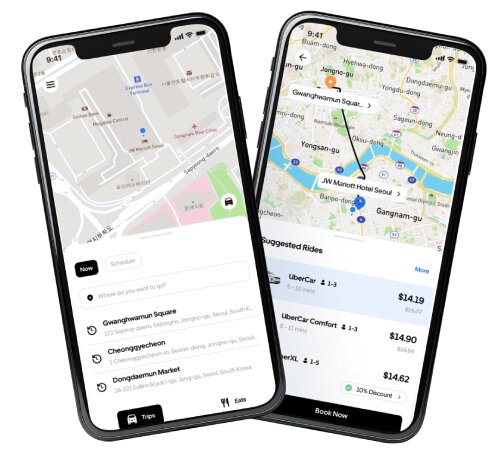Ride-sharing apps have seen success and have become prominent businesses in the digital mobility market. Even so, having a top app only matters if you can monetize it well, which determines your actual return. Anyone aiming to maximize business profits must pick the right way to bring in revenue. We provide information on the top earning strategies used by ride-sharing apps, along with their main factors for lasting revenue growth.
1. Commission-Based Monetization: The Core of Ride Sharing Profits
The commission-based model is the most widely adopted monetization strategy in ride sharing app development. In this model, the platform earns a fixed percentage from each transaction between the driver and the rider.
- Example: Apps like Uber and Lyft typically charge a commission between 15% to 30% per ride.
- This model ensures scalability—the more rides the platform facilitates, the more revenue it earns.
To maximize ROI with this model:
- Optimize driver onboarding to reduce churn.
- Implement dynamic pricing during peak hours.
- Offer loyalty programs to retain frequent users.
2. Surge Pricing: Capitalizing on Real-Time Demand
Surge pricing, also known as dynamic pricing, is another effective model where prices are increased during periods of high demand.
- This encourages more drivers to go online while managing demand from riders.
- Surge pricing is powered by advanced algorithms and GPS-based analytics.
Maximize ROI by:
- Integrating machine learning to predict peak hours.
- Using real-time data to adjust pricing accurately.
- Notifying users in advance to improve user trust.
3. Subscription Plans: Recurring Revenue with Predictability
Offering subscription plans for riders and drivers is a win-win strategy for both user retention and revenue stability.
- Riders can enjoy discounted rides, zero surge charges, and exclusive offers.
- Drivers may pay a monthly subscription for zero commission fees and priority ride allocation.
Key features:
- Build tiered pricing plans for different user segments.
- Use freemium plans to upsell premium packages.
- Track usage analytics to optimize plan benefits.
4. In-App Advertising: Monetize Without Disrupting User Experience
In-app advertising offers a high ROI by leveraging your user base without affecting core functionalities.
- Run targeted ads using AI and user behavior tracking.
- Integrate sponsored listings for local businesses or service partners.
- Employ native ads that blend with the UI for better engagement.
Revenue optimization tips:
- Partner with local brands and event organizers.
- Introduce location-based ads during rides.
- Avoid intrusive pop-ups to maintain user satisfaction.
5. Car Rental and Leasing Partnerships
Many ride sharing app development companies now offer vehicle leasing or rental programs to drivers who don’t own a car.
- The app acts as an intermediary between car rental services and drivers.
- It earns a referral fee, margin on leases, or recurring rental commission.
Implement this by:
- Partnering with car dealerships or rental companies.
- Offering flexible short-term leases.
- Providing incentives like free maintenance or fuel cards.
6. Corporate Ride Packages: Tapping into B2B Revenue Streams
Corporate packages allow companies to offer ride-hailing services for employees.
- A ride sharing platform can offer enterprise-level dashboards, expense tracking, and customized billing cycles.
- B2B contracts are typically high-value and long-term.
Ways to optimize:
- Provide bulk ride discounts for large corporations.
- Include premium support and priority bookings.
- Offer API integrations with enterprise systems for easy access.
7. Affiliate Marketing and Partner Integrations
Leverage affiliate partnerships to offer additional services like:
- Insurance
- Credit cards
- Travel booking
Monetize through:
- Commission per sale or signup
- In-app banners and promotional offers
- White-label partnerships with other service providers
This model enriches the app ecosystem while diversifying income streams.
8. Wallet System and Cashback Offers
Integrate a digital wallet within the app to increase user retention and improve cash flow.
- Users can load money and get cashback or reward points for every transaction.
- This encourages prepayments and improves average ride frequency.
Maximize ROI with:
- Gamified cashback offers.
- Tie-ups with credit card companies for reward points.
- Special wallet-only discounts to promote usage.
9. Tiered Driver Incentives: Encourage High Performance
Creating an incentive-based ecosystem for drivers helps improve service quality and boost revenue.
- Reward top-performing drivers with higher earnings, bonuses, and early payouts.
- Implement rating-based access to premium features.
Benefits:
- Higher driver retention.
- Improved rider satisfaction leading to more bookings.
- A positive feedback loop for the app’s reputation.
10. White Label Licensing: Monetize Your App Architecture
If your ride hailing app development infrastructure is robust, consider licensing your solution as a white-label product.
- Charge a one-time licensing fee or monthly subscription.
- Offer customization options, backend support, and cloud hosting.
This model suits startups wanting a quick market entry and allows you to monetize your technical expertise.
Conclusion: Diversify and Optimize for Maximum ROI
The most powerful ride-sharing platforms rely on more than one way to earn money. Platforms can achieve a steady stream of income by using commission, surging prices, subscription-based offers and advertising. With thoughtful ride hailing app development, backed by powerful data analytics and user-centric features, the road to profitability is wide open.
